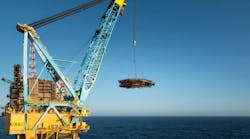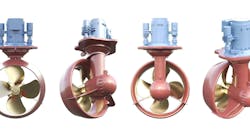Sell properties, buy shares!
Major offshore producers normally sell large blocks of non-core, regionally isolated, or marginal oil and gas properties during premium price conditions. When property premiums fall with oil and gas prices, then farm-out to smaller producers becomes the popular route to value exploitation.
A variation to the sell route has emerged in recent months. After selling their properties for cash, several major producers are quietly buying shares of the property purchaser's equity in order to capture the new value of the reserves. This situation brings up two questions:
- If the major producer's efforts are to capture greater value from the sale, does that not also say something about their own equity values and share buyback efforts?
- Is investing in smaller producers' equity the best way to put that new cash to work, and if so, does that say something about the value of their core exploration and development capabilities?
Investors appear to have rated the process positively for buyers and sellers, and the trend likely will continue until the property premium disappears or oil and gas prices fall. If the trend endures beyond that point, then it affirms a long-held notion: major producers are configured to hunt large reserves, smaller producers can hunt everything else, and there is risk and very little reward in crossover.
Rig price runup?
Investors have rewarded oil and gas suppliers and contractors that were successful in paring down inventory and developing a just-in-time manufacturing strategy. There is a down side to that lack of inventory in a cyclical market, and it's about to take effect.
US land rigs were first to be impacted, but shortages are becoming obvious for other equipment and in other areas of the world. Land oil and gas producers are putting everything that can cut hole to work finding new gas. There are very few rigs left and US rig contractors are boosting rates as fast as contract expirations allow in order to create enough cash flow to repay debt and contract for new-build rigs. US operators likely will see a large run-up in rig costs this year, and the same may hold true for some types of offshore rigs that have not experienced rate escalation in some time.
Oil prices will come down some by summer, and will probably settle somewhere in the $20-26/bbl range - sufficient to continue the expansion of non-OPEC E&P. US gas prices may not budge much because storage re-fill will start late after a hard winter, and gas production cannot be ramped up quickly enough to meet 2002 winter storage needs.
2000 was the year of recovery for the producers. 2001 appears to be the year of recovery for equipment and services providers. No one wants to panic, but the rumbling is starting.
Who's getting rich?
Guess how many US natural gas producers contracted out a substantial portion of their gas production for $2.00-$2.50/Mcf last spring and summer? Quite a few, it turns out. It was an excellent strategy for gas producers back then; their bankers said so. Those who held back on signing gas contracts are in the money too - just more of it. Now, all gas producers are searching feverishly for the new gas reserves they will need to capture any price premium left in the remaining 2001 and 2002 supply shortfall.
Imagine this combination: gas producers, driven by a supply short market and their bankers to find new gas reserves; and oil producers, who have postponed exploration and development for two years while they merged and purged, and allowed reserve replacement efforts to lapse.
The result could be a producer's run on viable acreage, on drilling units, and on production equipment. A cautious run, of course, because the lessons of 1998-1999 are still fresh. Producers have to go for solid equity growth this time - not just dividends. Investors are watching, and they haven't done that in quite a while.




